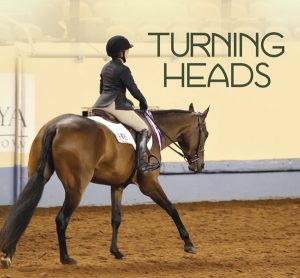Turning Heads – Perfecting the Headset in the Hunter Under Saddle Horse
Click here to read the complete article
When done right, there is nothing more beautiful to watch than a Hunter Under Saddle horse’s long flowing stride as it trots down the rail with its lengthy neck stretched out evenly from the withers and ears pricked forward as if it’s the most natural and easy thing in the world. But achieving that effortless appearance is anything but easy, as trainers and exhibitors will attest.
The AQHA rulebook clearly lays out what a Hunter Under Saddle horse should look like, saying a horse should “have a bright expression with alert ears, and should respond willingly to the rider with light leg and hand contact. Horses should be responsive and smooth in transition. When asked to extend the trot or hand gallop, they should move out with the same flowing motion. The poll should be level with, or slightly above, the withers to allow proper impulsion behind. The head position should be slightly in front of, or on the vertical.”
AQHA judge David Denniston explains that it’s important to think about the true purpose and origin of the class when selecting and judging the Hunter Under Saddle horse saying, “Hunter Under Saddle is a platform class and is meant to form a strong basis for advancing to Over Fence classes. Having said that, the Hunter Under Saddle frame should represent one that’s looking ahead and through the bridle as if it’s moving toward a fence. While the Hunter Under Saddle class is obviously a flat class and doesn’t have any fence requirement, the image the Hunter Under Saddle horse portrays should be one that shows the ability to advance from the flat class to an Over Fence class. The horse should be up in its shoulder and neck and move across the ground as if it’s traversing a hunt field.”
When it comes to head and neck position specifically, the rulebook lists faults when as the head is carried too high or too low, “such that poll is below the withers.” It also includes overflexing or straining of the neck so the nose is carried behind the vertical and excessive nosing out.











